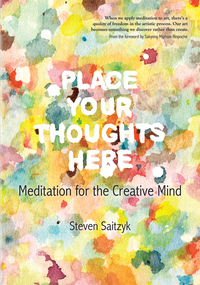I recently completed the Shambhala Art teacher training program in Los Angeles with one of my beloved teachers and mentors, Steven Saitzyk. A longtime student of Chögyam Trungpa Rinpoche, the renowned Tibetan Buddhist meditation master, Steve is a talented artist and art professor, and one of the premier Western teachers of contemplative arts. He helped to develop the Shambhala Art curriculum, based in Buddhist meditation and mindfulness traditions, and he recently released a wonderful book called Place Your Thoughts Here: Meditation for the Creative Mind that describes how meditation can enhance and enliven the creative process. I had the pleasure of interviewing Steve for our blog about meditation, creativity, and art-making:
Melinda: For artists and creatives who have never practiced meditation, how would you briefly describe the potential benefits of meditation for one's art-making process?
Steve: Finding just the ‘right’ psychological place to start one’s art making can be stressful. I call the search for that place, “finding a place to land.” People often develop little rituals in order to do just that. But, those rituals themselves can become distractions. I once knew a famous screenwriter who would repeatedly circumnavigate his computer until he felt he could take his seat and begin to write. It could take quite some time and frequently did not work. Developing a mindfulness meditation practice teaches us how we can place our mind where we want it to be. It helps us find that psychological space in which to land so we can begin. Meditation could be seen as a more efficient and less stressful way of arriving at a starting, or restarting, point. It provides the mental space for insight to arise and be recognized as such. If our heads are constantly filled with stuff, there is little room for something new and inspirational to take form. This increased awareness is the natural outcome of practicing mindfulness meditation. Meditation also helps us with our viewing process so we can see our work with fresh eyes and even glimpse how others might perceive the result of our creative process.
Melinda: In your experience as both a meditation practitioner / teacher and art professor, how would you compare and contrast traditional Western and Buddhist approaches to art and creativity?
Steve: For the most part, I feel that the Western approach to art and art making over-emphasizes self-expression and narrative. A Buddhist or meditative approach examines this by posing the question: What is the “self” that is being expressed? Is it ego, or what? A meditative approach advocates that we would be best served if we focused less on the “self” and more on the expression part of the creative process. Such an approach is called pure expression rather than self-expression, because one has learned through meditation how to let go of the relentless self-referencing, self-dialoging, self-consciousness, self-criticism, and so on, for at least a few moments, in favor of being relaxed, present, tuned-in, and responsive. Which, by the way, is not all that easy to do, but meditation sure helps. In terms of narrative, a meditative approach questions why we need to make a story out of everything we see, hear, taste, and so on. We might even ask why we need to make a story out of everything we do. Not everything is, or has, a story. Some things could be an experience, something to just appreciate.
Melinda: How has your own creative process evolved over the years, particularly once you began practicing meditation? And how has your art itself evolved?
Steve: I learned to trust not only who I am, but who I am not. My creative process has been one of learning that I can come back to what some call square one, or what I call original space, and trust it. That has been profound for me. I have come to better appreciate that discovering original space is not just a one-time event, but a process of returning to it over and over again in deeper and more inclusive ways. As for my own art, over the past decade, it can be loosely be described as a synthesis of abstraction and conceptual ideas. I use words, sometimes barely visible words, on, or in, a multicolored ground. I love the exploration of the place between felt sense and thought sense, where experience takes shape into thought and thought dissolves back into experience. You can see my work at www.stevensaitzyk.com.
Melinda: What's one piece of advice you would give to people experiencing a creative block, or who feel stuck with respect to their creative process?
Steve: If I have to offer only one, it would certainly be to develop a mindfulness meditation practice. One of the things people learn in practicing meditation is to not take themselves so seriously. After all, if we look at meditation practice, it would seem absurd. You choose to develop a practice to achieve certain goals such as to be more mindful, aware, and kind to yourself and others, but while you are practicing meditation you have to totally give up any hope of ever achieving anything. And, somehow that works.
With creative block we worry where the next inspiration is going to come from. We search all over the place. We try to think something up. We can’t seem to do it. And, yet when we sit and meditate we are essentially practicing the art of doing nothing, all the while we cannot seem to stop things from arising. It is like something my late teacher said. We each have our own stinky pile of manure, which we try to get rid of, and then we go to the nursery and buy other peoples manure in which to plant our garden. We could have just used our own manure. Inspiration is arising all the time, but we don’t recognize it from all the stuff that arises, so we toss it all out, or ignore it. Meditation is like taking a break. It provides the opportunity to feel some spaciousness, to take a fresh look and see what naturally arises and then to try it out, and then take another fresh look, and try that, and so on. Relax, something will arise, you cannot stop it from doing so. You just need to be present enough to perceive it. Meditation helps us with being present even when we are not meditating. That is called meditation-in-action.
Melinda: How is Place Your Thoughts Here: Meditation for the Creative Mind different from other books on art, creativity, and/or meditation?
There are books that talk about meditation. There are books that talk about art. There are books that talk about both in parallel, but my book specifically talks about how meditation and one’s creative process work together, how they inform and benefit each other. I also explain the contemplative viewing process, and take on subjects that others steer away from such as the source of originality, conditional and unconditional beauty, presence, and the sublime and how each of them not only applies to our creative process, but how we live our lives.
Steven Saitzyk is an Adjunct Professor of Humanities and Sciences at Art Center College of Design and the International Director of Shambhala Art, a nonprofit arts education program designed to integrate meditation into the creative process. See: www.shambhalaart.org and www.stevensaitzyk.com. He is a painter, author, and has practiced and taught meditation internationally for more than thirty-five years.



 RSS Feed
RSS Feed
